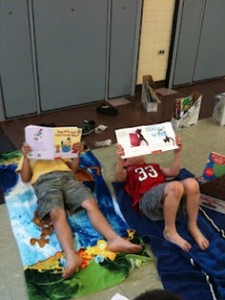Our school has several unique challenges when it comes to fostering a reading culture. We are an alternative public high school with over 3000 students, 3 campuses and day,  night, online and paper based classes for students aged 14 to 90. We run multiple specialty programs such as our multi-generational First Nations Graduation program, young adult Fast Forward Program, Adult Grad Program and teenage Futures Program. Consequently, the school often lacks a cohesive approach to anything as our basic philosophy is to differentiate everything according to student need. Our success lies in the ability of our different parts to tailor for specific groups in a responsive and timely manner. Add to this, no library (concrete or digital) and what you have is many different people fostering reading cultures in many different ways at all times.
night, online and paper based classes for students aged 14 to 90. We run multiple specialty programs such as our multi-generational First Nations Graduation program, young adult Fast Forward Program, Adult Grad Program and teenage Futures Program. Consequently, the school often lacks a cohesive approach to anything as our basic philosophy is to differentiate everything according to student need. Our success lies in the ability of our different parts to tailor for specific groups in a responsive and timely manner. Add to this, no library (concrete or digital) and what you have is many different people fostering reading cultures in many different ways at all times.
Of interest, however, was our new principal’s attempt to foster a collaborative reading culture by distributing a novel he is passionate about to the staff and requesting a book club. However, three things were missing: (1) staff interest (book choice/topic did not originate from staff), (2) options (over 40 teachers were given the same book), and (3)  collaboration options (when and how teachers would meet). Our curriculum support teacher met with our principal and suggested the following: (1) a survey of staff to see if staff book clubs were of interest to them and, if so, what topics they interested in, (2) a minimum of three options, one of which should be a video, and (3) a minimum of three options of when and how to meet. This situation highlighted the importance of relevance, interest, choice and differentiation for all readers, student or teacher.
collaboration options (when and how teachers would meet). Our curriculum support teacher met with our principal and suggested the following: (1) a survey of staff to see if staff book clubs were of interest to them and, if so, what topics they interested in, (2) a minimum of three options, one of which should be a video, and (3) a minimum of three options of when and how to meet. This situation highlighted the importance of relevance, interest, choice and differentiation for all readers, student or teacher.
I think the most important strategy would be time carved out for reading during school time. This could be at different times but would need to be a minimum of 20 minutes at least every second day. As well, all adults in the building would need to visibly  participate and relevance, interest, choice and differentiation would need to be emphasized and modeled. Finally, access to diverse reading material (likely digital) would be crucial. We are currently investigating a digital library as space is an issue at all campuses.
participate and relevance, interest, choice and differentiation would need to be emphasized and modeled. Finally, access to diverse reading material (likely digital) would be crucial. We are currently investigating a digital library as space is an issue at all campuses.
Modeling a passion for reading, respect for all types and genres of literature and respect for student choice has worked for me as a classroom teacher. What has not worked is: inconsistency, too short of time, no adult modeling and one novel fits all. I think a next step to build on the strategy above (school wide reading) would be digital book club forums where students and staff could blog about what they are reading, comment on each other’s’ posts and even create discussion groups if reading the same text.
Thanks for bringing up the idea that we need to incorporate reading into our day. This is certainly not a novel idea (see Drop Everything and Read), but it feels somewhat controversial when as teachers we have so much “to cover.” I have been working to incorporate at least 20 minutes of reading every other day (it is a great way to transition from outside lunch play time to inside class/work time), but each time I do this I feel really guilty. This guilt is not justified, but I can’t help feeling that this time is at the expense of something else we need to learn (our unit on 2D and 3D shapes, for example).
Yet, I consistently come back to the idea that this is the most precious time for my students. A time to get lost in a book. To indulge. To enjoy.
What a wonderful gift to give to them, and to ourselves!
I agree with that “guilty” feeling! I’ve also found (at least in an alternative secondary setting) that if I do silent reading first thing in the morning, a large number of students then consider the class to start 20 minutes later and wander into class accordingly (when the ‘real’ instruction starts). The classroom culture, if unconsciously, sees it as supplemental. I’ve taken to springing it on them randomly and the silent fixation of 25 teenagers happily reading is enough to reassure me.:)
Hi Devon,
Wow. Your school sounds like an interesting place and thus must have a very big staff. Thanks for sharing. I, too, started a professional book club at my school. However, as I knew that everyone was very busy, I decided to use research articles to kick start our discussions. Initially we were going to meet after school but it was hard to organize it around everyone’s busy schedules. Thus, we ended up meeting once a month at lunch (seemed manageable for everyone). I brought in treats and beverages as a motivator and it was a really positive experience. I provided the first articles (mostly around motivation) but at our first meeting I had everyone do a quick survey to see what topics they would be interested in exploring and invited them to choose articles for the group. Last year, we tackled a book (at the suggestion of administration) and it didn’t seem to work out quite as well. Although the book was very interesting, the group shrank and many said they felt more pressure to read it.
I also liked the idea of including a video or digital aspect. After viewing some videos online for this course, I can see how I would use some of them during a professional day to spark conversation.
With regards to providing reading time each day, I love the idea of trying to include at least 20 minutes. My son (grade 4) loves reading this year and he has commented on the fact that they get 30 minutes a day to read books that they choose. Time and choice…
Good blog post! I really liked the discussion of your specific experience in your district with the staff book club. This example clearly demonstrates some of the key problems with ‘top-down’ design, withholding choice, interest and control over when/how it is implemented and discussed. I liked the solutions your district explored, bringing in choice and varied resources around the same topic. A good solution that will encourage more involvement and hopefully better engagement. Overall, an insightful post into a unique situation!
I really appreciate your comments regarding the importance of adult participation and modeling. I totally agree. If we are engaged in reading, kids understand that it is important and worthwhile. We need to be able to talk books with kids. We don’t have to read everything in our library but if we can honestly say, yes, I loved Ruins of Gorland, or whatever, conversations start and reading takes center stage. Also, what better way to be able to steer kids toward just right books?
Thanks for your thoughts!
Wow! What a diverse audience of learners you support! I can imagine that it would be hard to develop a culture of reading with all the various ways people are accessing their information. However, I do think you have tapped into something important, the fundamentals of a reading culture: do it often, and do it collectively. Teacher modelling is key! Good luck 🙂